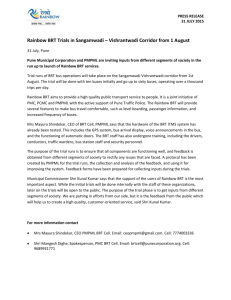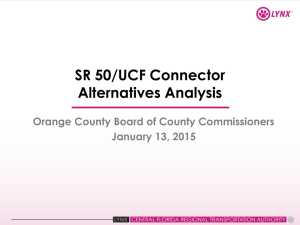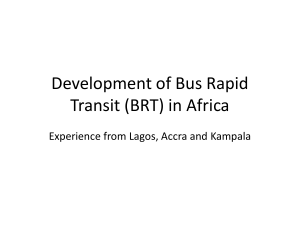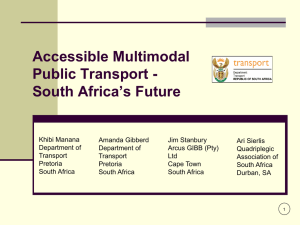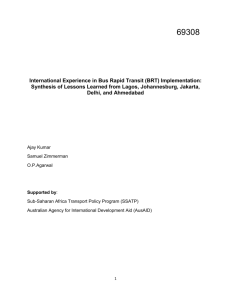BUS RAPID TRANSIT IN PERMANENT EVOLUTION Darío Hidalgo
advertisement
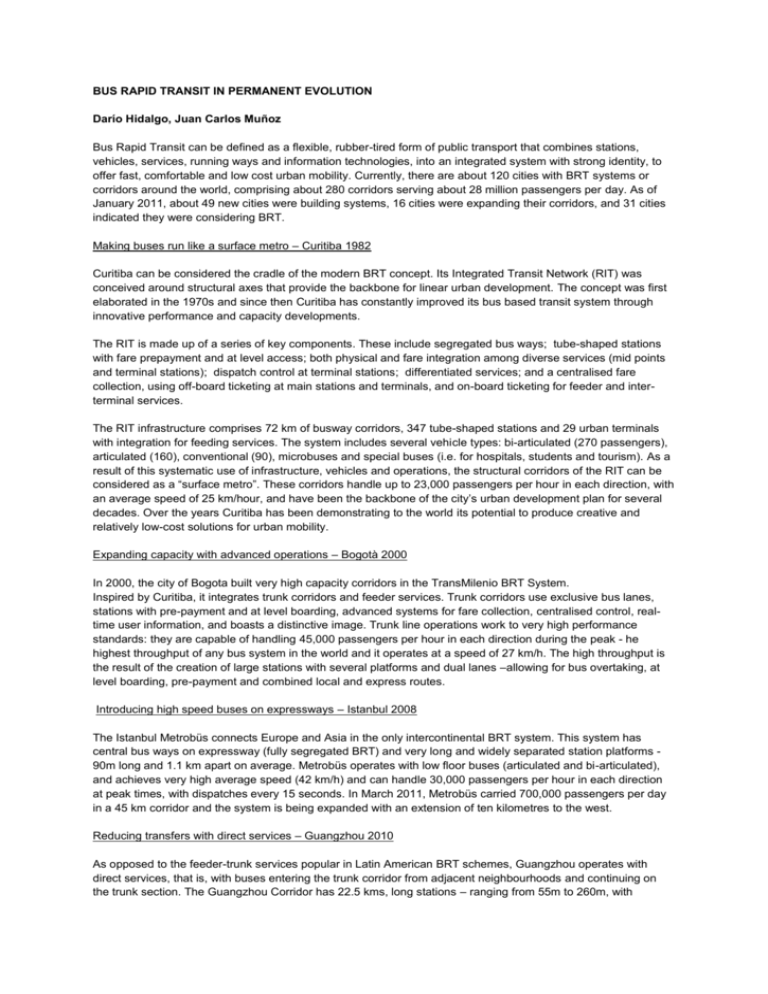
BUS RAPID TRANSIT IN PERMANENT EVOLUTION Darío Hidalgo, Juan Carlos Muñoz Bus Rapid Transit can be defined as a flexible, rubber-tired form of public transport that combines stations, vehicles, services, running ways and information technologies, into an integrated system with strong identity, to offer fast, comfortable and low cost urban mobility. Currently, there are about 120 cities with BRT systems or corridors around the world, comprising about 280 corridors serving about 28 million passengers per day. As of January 2011, about 49 new cities were building systems, 16 cities were expanding their corridors, and 31 cities indicated they were considering BRT. Making buses run like a surface metro – Curitiba 1982 Curitiba can be considered the cradle of the modern BRT concept. Its Integrated Transit Network (RIT) was conceived around structural axes that provide the backbone for linear urban development. The concept was first elaborated in the 1970s and since then Curitiba has constantly improved its bus based transit system through innovative performance and capacity developments. The RIT is made up of a series of key components. These include segregated bus ways; tube-shaped stations with fare prepayment and at level access; both physical and fare integration among diverse services (mid points and terminal stations); dispatch control at terminal stations; differentiated services; and a centralised fare collection, using off-board ticketing at main stations and terminals, and on-board ticketing for feeder and interterminal services. The RIT infrastructure comprises 72 km of busway corridors, 347 tube-shaped stations and 29 urban terminals with integration for feeding services. The system includes several vehicle types: bi-articulated (270 passengers), articulated (160), conventional (90), microbuses and special buses (i.e. for hospitals, students and tourism). As a result of this systematic use of infrastructure, vehicles and operations, the structural corridors of the RIT can be considered as a “surface metro”. These corridors handle up to 23,000 passengers per hour in each direction, with an average speed of 25 km/hour, and have been the backbone of the city’s urban development plan for several decades. Over the years Curitiba has been demonstrating to the world its potential to produce creative and relatively low-cost solutions for urban mobility. Expanding capacity with advanced operations – Bogotà 2000 In 2000, the city of Bogota built very high capacity corridors in the TransMilenio BRT System. Inspired by Curitiba, it integrates trunk corridors and feeder services. Trunk corridors use exclusive bus lanes, stations with pre-payment and at level boarding, advanced systems for fare collection, centralised control, realtime user information, and boasts a distinctive image. Trunk line operations work to very high performance standards: they are capable of handling 45,000 passengers per hour in each direction during the peak - he highest throughput of any bus system in the world and it operates at a speed of 27 km/h. The high throughput is the result of the creation of large stations with several platforms and dual lanes –allowing for bus overtaking, at level boarding, pre-payment and combined local and express routes. Introducing high speed buses on expressways – Istanbul 2008 The Istanbul Metrobüs connects Europe and Asia in the only intercontinental BRT system. This system has central bus ways on expressway (fully segregated BRT) and very long and widely separated station platforms 90m long and 1.1 km apart on average. Metrobüs operates with low floor buses (articulated and bi-articulated), and achieves very high average speed (42 km/h) and can handle 30,000 passengers per hour in each direction at peak times, with dispatches every 15 seconds. In March 2011, Metrobüs carried 700,000 passengers per day in a 45 km corridor and the system is being expanded with an extension of ten kilometres to the west. Reducing transfers with direct services – Guangzhou 2010 As opposed to the feeder-trunk services popular in Latin American BRT schemes, Guangzhou operates with direct services, that is, with buses entering the trunk corridor from adjacent neighbourhoods and continuing on the trunk section. The Guangzhou Corridor has 22.5 kms, long stations – ranging from 55m to 260m, with overtaking lanes - and combines multiple direct services on the same infrastructure. It allows up to 27,000 passengers per hour in each direction, with 350 buses per hour. The Guangzhou BRT carries 800,000 passengers per day, which is the highest BRT load in the world: 35,500 passengers/km. The very high usage of the corridor is partially the result of the density along its alignment and the mix of activities, which result in very high passenger rotation and low peak factors. The corridor operates at quasi-peak conditions for 14 hours a day. Improving dispatch and centralised control Centralised dispatch and control is becoming a standard feature of BRT systems, especially those with high frequency services. These features are standard in rail networks and their adoption in bus based operations increases safety, reliability and user satisfaction. They also provide very significant improvements in recovery time after incidents. Average frequencies are directly related to the level of service provided to passengers since higher frequencies obviously reduce waiting time and increase capacity. However, two systems offering the same average frequency can be perceived quite differently by passengers and may have contrasting cost structures. The cost for passengers and operators are reduced if buses run on strictly regular headways. However, this regularity is extremely difficult to achieve and uncontrolled buses invariably bunch. On medium to low frequency (fewer than five buses per hour) routes, services are usually controlled through a schedule. However, BRT usually operates on a much higher frequency where there is no necessity for schedules. In this case bunching is a serious issue that significantly affects performance. Average waiting times can be twice their planned level, and passengers may experience far longer waits. Lack of reliability not only affects waiting time, but also causes an uneven distribution of passengers on buses, with some being completely full and others rather empty. During peak periods when the maximum capacity of the buses is needed, this is a serious problem since conditions inside the bus can become really uncomfortable and passengers may need to wait for the next bus, extending their delay even further. On the operational side, average cycle times increase, which affects capacity and running time variability, making driver and bus operations at terminals more difficult and costly. So far, few BRT systems worldwide are equipped with a headway control system other than regulating dispatches at the terminals. Moreover, most systems with headway control rely on human visualization of vehicle positions (reported by GPS) over a monitor. Such a tool does not provide an adequate control mechanism since human reactions are imprecise, making bunching unavoidable. Introducing flexibility in BRT operation The most common application of BRT is an all-stop local service local. Nevertheless, buses are flexible and operations can benefit from that flexibility. For instance, flexibility may include dispatching empty buses to reach and serve busy terminals (deadheading), making short loops, or introducing limited-stop and direct services. Deadheading can be introduced when demand is significantly unbalanced between both directions. In such a case a deadheaded service that runs non-stop in the less loaded direction may improve the capacity of the most loaded direction, without increasing the number of buses. Short loops can increase supply in a section of the corridor, without the need for significant numbers of extra vehicles. This strategy allows the operator to tailor the capacity far more accurately to meet the demand. If buses can also overtake each other on the corridor, then some limited-stop and even direct services should be offered. Limited stop services serve only a predefined subset of stops and allow the operator to increase the average speed on the corridor while raising the capacity of the system at a low cost. Another advantage is that the operational cost per kilometre is usually reduced since buses accelerate and decelerate less frequently and doors are opened less often. It comes at the expense of higher waiting times for passengers travelling on lowdemand origin-destination (O-D) pairs. These services are more attractive for very heavily loaded corridors, long trips and where demand is concentrated on a few O-D pairs. These opportunities for flexibility are even more significant for networks of BRT corridors and their feeder services. The design should balance the efficiency of these services with the passengers’ general aversion to transfer buses. This brings in the issues of providing routes which serve more than one corridor and having feeder services entering the corridor. Allowing feeders to enter the corridor is complicated since it requires bus- station compatibility to be flexible, and can also require special traffic control procedures outside the corridor to mitigate the irregularity of arrivals of the feeder services at the corridor Providing a broad range of services has proved very effective. There are systems already using some of these strategies: for instance, Quito introduced short loops in its BRT, Bogotá combines local and express services in the same infrastructure as well as routes from several corridors, Guangzhou operates with direct services reducing transfers, and Curitiba recently upgraded the original BRT corridors to allow for bus overtaking, increasing capacity and reducing passenger travel times. Dynamic bus priority Achieving a high average speed is crucial for BRT success not just because passengers prefer a fast trip, but because it affects capacity. Thus, operators should make every effort to keep commercial speeds as high as possible. This means segregating bus flows from the rest of the traffic (including taxis), reducing dwell times and eliminating instances where the bus must stop. The ideal solution depends on the bus frequency in the corridor. In those with very high frequency segregated lanes and even special infrastructure such as underpasses or flyovers for buses to avoid intersections should be considered. In corridors with medium frequency communication devices can enable traffic signals to give priority to approaching buses. This coordination between buses and traffic signals can be improved further if headway regularity is also considered in the setting of green lights. Running way guidance Some BRT applications have introduced guidance systems to increase speeds in narrow corridors, improve safety, prevent unauthorized vehicle use and improve docking by reducing the horizontal gap at stations. There are three types of guidance systems: mechanical, optical, and magnetic. Guidance provides better performance, by improving travel time, reliability, image, safety, capacity and accessibility. Guidance systems make BRT feasible in very narrow right of ways and improve access for people with disabilities. Nevertheless, it introduces complexity and involves additional capital as well as operational costs. New vehicle propulsion technologies Current commercially-used technologies include conventional diesel, compressed natural gas CNG, liquefied natural gas LNG, electric (trolleybuses), and hybrid-electric drives. Prototype technologies include hydraulic hybrids, battery-electric, and hydrogen-powered buses. The impetus for developing these new propulsion technologies arises from the desire to improve the energy efficiency and reduce emissions, both of local air pollutants and greenhouse gases. Diesel is still the most widely employed form of propulsion in public transport, thanks to its low cost and efficiency, but there are major concerns about its large emissions, especially when high sulphur diesel oil and engines not equipped with particle filters are used. As a result, there has been extensive research and development by vehicle manufacturers to comply with increasingly strict emissions standards. Concerns have been addressed through the reduction of the fuel´s sulphur content, engine improvements, filters and catalytic converters. Diesel engines with cleaner fuel are expected to evolve; nevertheless the cost of fuel is expected to rise, as well as concerns about very fine particles and black carbon. As a result, evolution of BRT vehicles to other fuels and engines is expected. CNG engines have been increasingly used in public transport operations; they are regarded as clean, due to the lack of particulate matter, but still give out harmful emissions. The introduction of more efficient engines and aftertreatment devices allow CNG to meet strict environmental standards but concerns remain with the length of time it takes to refuel and vehicle autonomy. CNG is usually more expensive than diesel in terms of both capital and maintenance costs. Electric buses, or trolleybuses, operate with electric engines connected to the power grid through overhead wires. They have zero tailpipe emissions but obviously they need to be considered at the power source. Their implementation is restricted as a result of the higher operating and infrastructure costs as well as the negative aesthetic impacts of overhead wire systems. The concern for overhead wires is being addressed with underground lines and ultrafast battery charge at bus stops. Hybrid electric uses an internal combustion engine to drive an electric motor, reducing energy consumption and emissions. Most hybrids in commercial operation have a parallel configuration. Two engines are attached to the transmission, and the electronic control chooses which one to use: electric for low speed, combination at medium speed and internal combustion engine at high speed. There are multiple applications of this technology in bus systems, and the market is expected to continue growing as capital and maintenance costs are reduced. There are several other technologies under research and development. A promising one in the short term is the series hybrid. This involves an internal combustion engines that drives an electric generator, which charges a battery. The electric motor that provides traction is always fed through the battery, which is also recharged when brakes are applied. Other propulsion technologies that could be introduced in the medium and long term in commercial operations, include hydraulic hybrids; battery electric and hydrogen power. There are several prototypes and some for these technologies, including an operation with 300 electric buses in Shenzhen, China, but there are still issues with their capital costs. In the case of hydrogen, the main barrier is the highly energy intensive production process. The BRTs of the future BRT has come a long way since bus priority measures were first introduced in Chicago in 1939. It is no longer a bus on a busway, but rather an integrated system with several components to provide better quality of service and adapted to local demand. Breakthroughs in places like Curitiba, Bogotá, Istanbul and Guangzhou, have helped evolve both the concept and application. Research and development continues, and in the near future we expect BRT to include several advanced features. BRT will be a component of integrated public transport systems in most cities of the world. It will provide for good connection with pedestrian and bicycle infrastructure, and vehicle sharing systems. Buses will enjoy priority in the design of complete streets and signal systems, in some cases with dynamic bus lanes. BRT will increasingly incorporate several technological advances, including clean fuels and engines, automatic guidance, and communications with central dispatch and control. Service programming and control will take full advantage of advanced information technologies, with integration to the signals, sophisticated on-line control to improve reliability, and multiple types of services, such as short loops, deadheading, skip-stop, express and direct routes. The fare collection cards used in BRT systems will have multiple uses, and in many cases will be integrated into cellular phones, directly discounting fares from electronic accounts. Fare systems will be able to differentiate time of the day, day of the week and distance, and will charge usage according to supply and demand conditions. In addition, user information will be dynamic, with electronic variable message signs, video screens or messages to cell phones (SMS) indicating best routes, next services, as well public announcements in electronic boards. BRT will provide increased support to mixed use and high density urban development, which in turn will increase BRT ridership and impact. The contracts with service providers will be entirely based on performance, with adjustment of payment reflecting changes in service delivery, input costs, and public subsidies. Finally, infrastructure, technology, training, education and control will help in significantly reducing accidents and fatalities, and will foster physical activity, low or zero emissions and universal accessibility -for people with limited mobility. Abstract This paper shows how Bus Rapid Transit has evolved from simple bus priority measures to an integrated approach for better service provision. We show how cost effective solutions have been continuously evolved to improve the level of service, including some emblematic breakthroughs in BRT evolution in cities like Curitiba, Bogota, Istanbul and Guangzhou. We also present new research and development activities that will continue to shape BRT evolution in the coming years.
